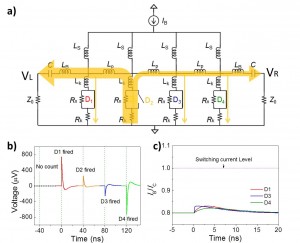Position Readout of a Superconducting Nanowire Single-photon Detector Array by Inductive Current-splitting
- Category: Optics & Photonics
- Tags: karl berggren, qingyuan zhao

Figure 1: a). Schematic of a 2-bit position array by inductive current splitting. The detectors are biased at IB. LS is the choke inductor. LK is the total kinetic inductance of the nanowires, including the active nanowires and the nanowire-inductors. RK is the on-chip Ti/Au resistor. LB, C, and Z0 are the inductance of bonding wire, coupling capacitor, and input impedance of the readout circuit, respectively. The orange arrows show the current distribution when the second detector D2 is fired. The width of each arrow is proportional to the amplitude of the current. b). The simulated waveforms of the differential output, VL–VR. The position information can be clearly read by the amplitude of the pulses. c). The current fluctuation in the unfired detectors when the second detector D2 is fired. All the detectors are biased at 0.8 IB/IC. The maximum overshot is 3% of IC showing the array can work steadily without being affected much by the fired detector.
Single pixels of superconducting nanowire single photon detector (SNSPD) have high detection efficiency, low dark-count rate, and low timing jitter. To achieve a large active area, spatial resolution, or photon-number resolution, an SNSPD array is a promising approach for applications in quantum-information processing, single-photon imaging, and deep-space communication. However, designing a readout scheme is a serious challenge for multi-pixel detector arrays. Two groups have previously used single flux quantum (SFQ) to multiplex the array and have reported some experiment results on single detector [1] [2] . This method is useful for large-scale SSPD array but Josephson junctions are needed to be fabricated on the same chip and increase the complexity of the fabrication.
For a medium sized SNSPD array, we propose a simple design using only an on-chip integrated inductor and resistor network. The positions and number of detectors that have received a photon are read by the combination of difference and sum signals of the pulses in the two outputs. The maximum size of the array is limited by the amplitude of the differential output signal, the electric noise, the sensitivity of the readout circuit, and the circuit element variability. To overcome these limitations and increase the size of the array, we made improvements over conventional superconducting nanowire single photon detectors in two ways. First, we redesigned the detector to operate by a multi-stage avalanche mechanism, which increases the output signal dramatically. Second, we added a cryogenic amplifier with a low-loss connection to the readout circuit, increasing the signal-to-noise ratio by a factor of ~4. Additionally, to construct the array, we have designed and tested on-chip resistors. We also simulated and analyzed the array in a lumped circuit element and electro-thermal model. Based on simulation results, the size of an array resulting from this approach could be over 100 elements.
- S. Miki, H. Terai, T. Yamashita, K. Makise, M. Fujiwara, M. Sasaki, and Z. Wang, “Superconducting single photon detectors integrated with single flux quantum readout circuits in a cryocooler,” Applied Physics Letters, vol. 99, no. 11, pp. 111 108, 2011. [↩]
- T. Ortlepp, M. Hofherr, L. Fritzsch, S. Engert, K. Ilin, D. Rall, H. Toepfer, H. G. Meyer, and M. Siegel, “Demonstration of digital readout circuit for superconducting nanowire single photon detector,” Opt. Express, vol. 19, no. 19, pp. 18 593-18 601, Sep. 2011. [↩]